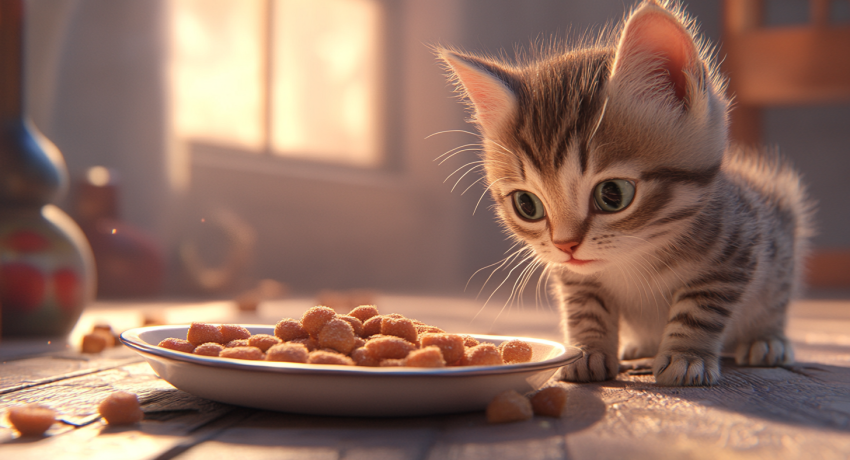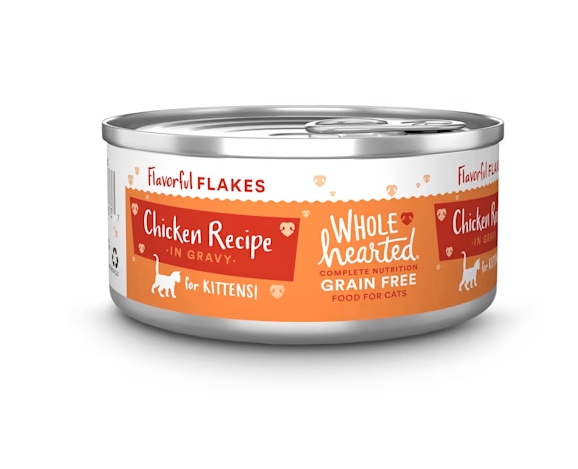
WholeHearted Grain-Free Chicken Recipe Flakes in Gravy Wet Kitten Food, 5.5 oz., Case of 12
- The WholeHearted Grain-Free Chicken Recipe Flakes in Gravy Wet Kitten Food serves up a chunky texture your kitten will adore. These tasty pieces of chicken chopped in savory gravy will treat their taste buds to flavorful flakes while filling up their tummies with the nutrients they need to grow happy and healthy.
- – Grain-Free Chicken Recipe Flavorful Flakes in Gravy Wet Kitten Food from WholeHearted
- – DHA to help support healthy brain development
- – No artificial colors or flavors
- – No corn, wheat, or grains of any kind
- – Antioxidant nutrients help support a healthy immune system
- – Omega 3 & 6 fatty acids aid in maintaining a healthy skin and coat
$17.40
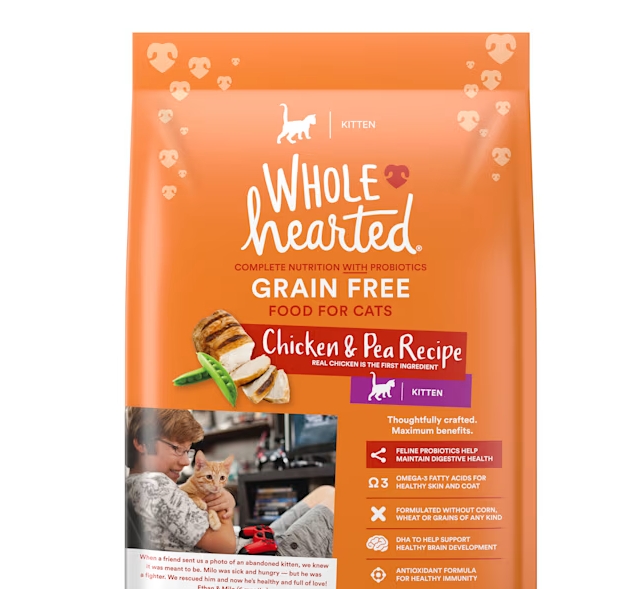
WholeHearted Grain-Free Chicken Recipe Dry Kitten Food, 12 lbs.
- The WholeHearted Grain-Free Chicken Recipe Dry Kitten Food fills your four-legged little one’s bowl with goodness they need to grow. Thoughtfully crafted with maximum benefits, this recipe features real chicken as the 1st ingredient along with feline probiotics for healthy digestion and fatty acids that help hydrate their locks. It also keeps their brain development in mind with a supplement of DHA to support their smarts.
- – Real chicken is the 1st ingredient
- – Feline probiotics to help maintain digestive health
- – Omega-3 fatty acids for healthy skin and coat
- – DHA to help support healthy brain development
- – Antioxidant formula for healthy immunity
- – No corn, wheat, or grains of any kind
$31.99
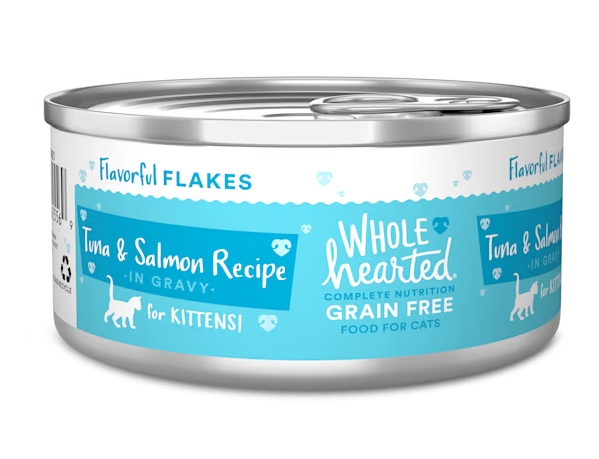
Wholehearted Grain-Free Tuna & Salmon Recipe in Gravy Wet Food for Kittens, 5.5 oz., Case of 12
- The WholeHearted Grain-Free Tuna & Salmon Recipe in Gravy for Kittens features a unique formula designed especially to support your kitten’s healthy growth with DHA and without corn, wheat, grains or artificial colors or flavors.
- – Grain-Free Tuna & Salmon Recipe in Gravy for Kittens from WholeHearted
- – DHA helps support healthy brain development
- – No artificial colors or flavors
- – No corn, wheat or grains of any kind
$17.40
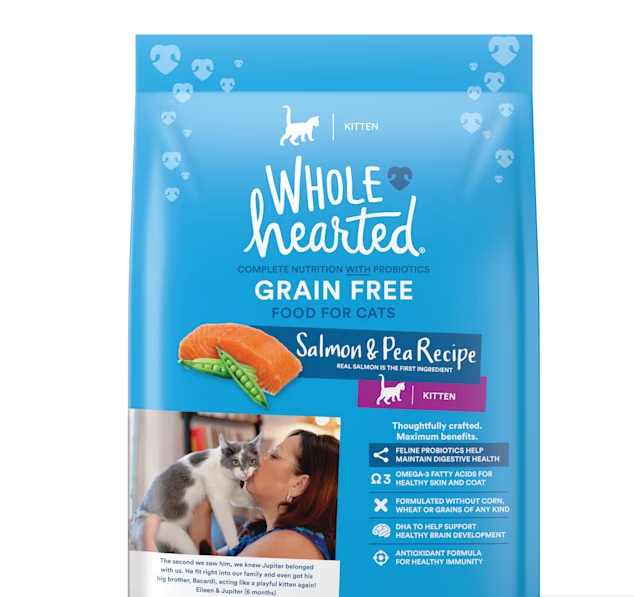
WholeHearted Grain-Free Salmon Recipe Dry Kitten Food, 12 lbs.
- The WholeHearted Grain-Free Salmon Recipe Dry Kitten Food fills your four-legged little one’s bowl with goodness they need to grow. Thoughtfully crafted with maximum benefits, this recipe features real chicken as the 1st ingredient along with feline probiotics for healthy digestion and fatty acids that help hydrate their locks. It also keeps their brain development in mind with a supplement of DHA to support their smarts.
- – Real salmon is the 1st ingredient
- – Feline probiotics to help maintain digestive health
- – Omega-3 fatty acids for healthy skin and coat
- – DHA to help support healthy brain development
- – Antioxidant formula for healthy immunity
- – No corn, wheat, or grains of any kind
$32.99
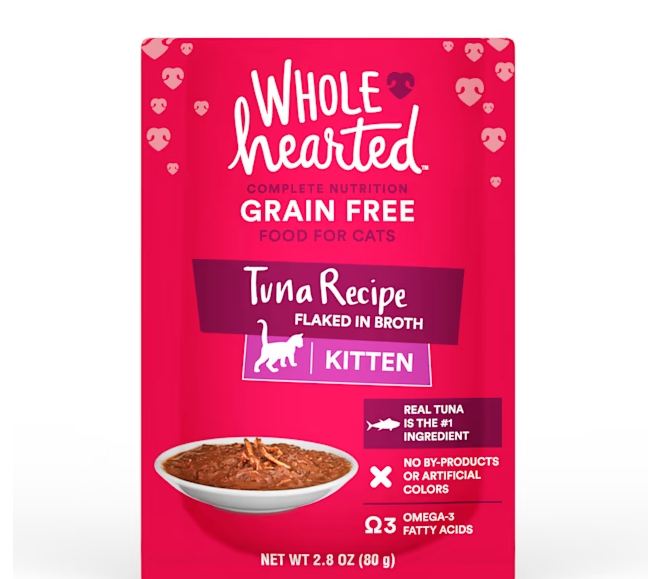
WholeHearted Grain Free Tuna Recipe Flaked in Broth Wet Kitten Food, 2.8 oz., Case of 12
- The WholeHearted Kitten Food Pouch fills your young feline with the nourishment necessary for healthy development. Nurture their body and mind with wholesome goodness packed into a scrumptious tuna flavor that will have them purring.
- – Grain Free Flaked Tuna Wet Kitten Food from WholeHearted
- – Real tuna is the number one ingredient
- – No by-products or artificial colors
- – Omega-3 fatty acids to promote healthy skin and coat
- – Offers complete feline nutrition
$10.68
Navigating the World of Nutrition for Your Furry Family Member
When I brought home my little ball of fluff, Whiskers, I had no idea how overwhelming the world of kitten nutrition could be. Standing in that pet store aisle, surrounded by countless bags and cans, each promising to be the best for my new family member, I felt completely lost. That’s when I discovered Wholehearted kitten food, and it changed everything about how I approached feeding my growing companion.
If you’re anything like me, you want nothing but the best for your kitten. The right nutrition during the first year of your kitten’s life is absolutely crucial for their development, and choosing the right food is one of the most important decisions you’ll make as a new cat parent. After extensive research, personal experience, and countless conversations with other kitten owners and veterinarians, I’ve put together this comprehensive guide to Wholehearted kitten food to help you navigate this important choice.
What Exactly Is Wholehearted Kitten Food?
Before discovering Wholehearted, I cycled through several brands, watching Whiskers turn his nose up at some and devour others without much rhyme or reason. Then a fellow cat parent recommended Wholehearted, and I decided to give it a try.
Wholehearted is Petco’s private label brand, launched in 2016 with a mission to provide quality nutrition at an accessible price point. What immediately drew me to their kitten formulas was their focus on high-quality protein sources and their commitment to avoiding artificial ingredients.
When I first opened a bag of Wholehearted kitten food, I was struck by how different it looked from some of the cheaper brands I’d tried. The kibble was appropriately sized for Whiskers’ tiny mouth, and even I could tell the quality difference just from the aroma. But looks can be deceiving, so I dug deeper into what actually makes up this food.
Breaking Down the Ingredients
The ingredient list was my first stop when evaluating Wholehearted. As someone who tries to eat healthy myself, I believe what goes into my kitten’s body is equally important.
What I found was impressive. The dry kitten food formulas typically list real meat as the first ingredient – usually chicken or salmon. This immediately told me that protein was the priority in these formulations, which is exactly what growing kittens need.
Here’s a breakdown of the key ingredients I found in most Wholehearted kitten formulas:
Wholehearted’s dry kitten food generally contains:
- Real meat as the first ingredient (typically chicken or salmon)
- Animal-based protein sources (chicken meal, salmon meal)
- Healthy fats (chicken fat preserved with mixed tocopherols)
- Complex carbohydrates (depending on formula, some are grain-free)
- Added taurine (essential for heart and eye health)
- Probiotics for digestive health
- Omega fatty acids for coat and skin health
- Vitamins and minerals
Their wet food formulas follow a similar pattern, with real meat leading the ingredient list, minimal carbohydrates, and added vitamins and minerals.
What I didn’t find was equally important: no artificial colors, flavors, or preservatives. No meat by-products or anonymous “meat meals” where you can’t identify the source. No corn, wheat, or soy – common allergens that many cats have trouble digesting.
I remember reading the ingredient list aloud to my mother, who has had cats for decades, and she commented on how much cat food has evolved since she first became a cat owner. “In my day, you just bought whatever was on sale,” she told me. “We didn’t know about all these nutritional needs.”
Nutritional Value: Is It Actually Good for Kittens?
Ingredients tell only part of the story. What really matters is the nutritional profile and whether it meets the specific needs of a growing kitten.
Kittens require more calories, protein, and certain nutrients compared to adult cats because they’re building muscle, bones, and organs at a rapid rate. A food might have great ingredients but still miss the mark on these essential nutritional requirements.
After comparing the nutritional analysis on several Wholehearted kitten formulas with AAFCO (Association of American Feed Control Officials) guidelines for kitten growth and development, I found that Wholehearted meets or exceeds the recommended levels for key nutrients:
The dry kitten formulas typically contain:
- 34-40% protein (higher than many competitor brands)
- 18-20% fat (providing energy for playful kittens)
- High levels of DHA for brain and eye development
- Balanced calcium and phosphorus for proper bone growth
- Added vitamins A, E, and C for immune support
What impressed me most was the protein content. At 34-40%, it’s significantly higher than the minimum AAFCO requirement and higher than many competing brands at the same price point. This extra protein helped Whiskers develop strong, lean muscles as he grew from a wobbly little kitten into the agile hunter he is today (even if he only hunts toy mice).
The high fat content might concern some pet parents, but it’s actually ideal for kittens. They burn energy constantly with their playful antics, and those healthy fats provide concentrated energy for growth and development. I noticed Whiskers had much more consistent energy throughout the day after switching to Wholehearted.
Grain-Free or Grain-Inclusive: Which Is Better?
One thing that initially confused me about Wholehearted’s kitten line was the choice between grain-free and grain-inclusive formulas. I had always assumed grain-free was automatically better, but my research revealed a more nuanced reality.
Wholehearted offers both options, and after speaking with our veterinarian, I learned that there’s no one-size-fits-all answer. While cats are obligate carnivores (meaning they require meat in their diet), some can digest and benefit from certain grains.
The grain-free formulas use alternatives like peas and potatoes for carbohydrates, while the grain-inclusive formulas incorporate brown rice and barley – whole grains that are generally more digestible than corn or wheat.
After trying both types with Whiskers, I found he seemed to digest the grain-free formula slightly better, with firmer stools and less litter box odor. However, this is highly individual, and some kittens may do better with the grain-inclusive options, especially if they have sensitivities to common ingredients in grain-free foods.
One important note: in recent years, there have been some concerns about grain-free diets and heart issues in dogs, but this connection hasn’t been established in cats. Still, I rotated between both types occasionally to provide variety and balanced nutrition.
Wet vs. Dry: The Eternal Debate
When I first adopted Whiskers, I assumed dry food was sufficient. It was more convenient, less expensive, and easier to measure. But then I noticed he wasn’t drinking much water, and after some research, I learned that cats naturally get much of their hydration from their prey in the wild, making wet food an important component of a domestic cat’s diet.
Wholehearted offers several wet food options for kittens, typically in 3 oz. cans or pouches. I started incorporating a can of wet food into Whiskers’ daily routine, usually split between morning and evening meals.
The difference was noticeable almost immediately. His coat became softer and more lustrous, and he seemed more energetic. The veterinarian also mentioned that the added moisture would benefit his urinary tract health long-term – a common issue for male cats as they age.
Wholehearted’s wet kitten foods follow the same quality standards as their dry formulas, with real meat as the first ingredient and no artificial preservatives or flavors. They come in several textures – pâté, morsels in gravy, and minced – which helped me discover Whiskers’ preferences (he’s a pâté enthusiast, in case you’re wondering).
While the wet food is more expensive than dry, I found that the combination approach gave us the best of both worlds: the convenience and dental benefits of dry kibble plus the hydration and palatability of wet food.
Available Flavors: Finding Your Kitten’s Favorite
Variety is the spice of life, and that applies to our feline friends too. Wholehearted offers several flavors in both their wet and dry kitten formulas, which helped me discover what Whiskers truly enjoys.
The dry kibble comes primarily in chicken and salmon varieties, with some formulas featuring a blend of proteins. The wet food has a wider range, including:
- Chicken recipe
- Turkey recipe
- Chicken & tuna
- Salmon & tuna
- Mackerel & tuna
I found that rotating flavors not only kept Whiskers interested in mealtime but also provided a broader spectrum of nutrients and amino acids from different protein sources. It also prevented him from becoming too fixated on one specific flavor, which can create problems if that formula ever becomes unavailable.
One delightful surprise was discovering his unexpected love for the mackerel formula. The first time I opened a can, he came running from across the apartment, meowing excitedly. It’s now our special weekend treat.
Feeding Guidelines: How Much and How Often?
Figuring out the right amount to feed Whiskers was one of my biggest challenges as a new kitten parent. Feed too little, and he wouldn’t get the nutrients needed for proper growth. Feed too much, and I risked setting him up for obesity later in life.
Wholehearted provides general feeding guidelines on their packaging based on age and weight, but I found these needed some adjustment for my particular kitten. Whiskers was exceptionally active, racing around the apartment like a miniature tornado for hours each day, so he needed slightly more than the recommended amount.
For most kittens, the feeding schedule looks something like this:
- 8-12 weeks: 4-6 small meals per day
- 3-6 months: 3-4 meals per day
- 6-12 months: 2-3 meals per day
I started with the recommended amounts on the package and watched Whiskers’ body condition closely. A healthy kitten should have a visible waist when viewed from above, and you should be able to feel but not see their ribs. If your kitten starts looking round or you can’t feel their ribs easily, it might be time to cut back slightly.
Free-feeding (leaving food available all day) isn’t generally recommended for kittens, as it can lead to overeating and doesn’t help establish regular eating patterns. I used measured meals at scheduled times, which also helped with litter box training since kittens typically need to eliminate shortly after eating.
By the time Whiskers reached 6 months, we had settled into a routine of three meals per day – a mix of wet and dry food – with the total daily amount based on his activity level and growth rate.
Price and Value: Is Wholehearted Worth It?
Let’s talk about the practical aspect that influences many of our decisions: cost. Pet food can range dramatically in price, from bargain brands to premium options that cost more than my own groceries.
Wholehearted positions itself in what I’d call the “affordable premium” category. It’s not the cheapest option on the shelf, but it’s significantly more affordable than many other brands with comparable ingredients.
A 5-pound bag of Wholehearted dry kitten food typically costs between $12-15, while a case of 24 3-oz cans of wet food runs about $25-30, depending on the specific formula and retailer.
To put this in perspective, feeding a kitten exclusively Wholehearted costs me about $30-40 per month, using a combination of wet and dry food. This was about 20-30% less than what I would have paid for other brands with similar quality ingredients.
When I consider the potential long-term health benefits and reduced veterinary costs associated with feeding a high-quality diet, I believe Wholehearted offers excellent value. My veterinarian confirmed this thinking, noting that proper nutrition now could help prevent costly health issues later in life.
Where to Buy Wholehearted Kitten Food
Since Wholehearted is Petco’s private label brand, the most reliable place to find it is at Petco stores or on their website. I typically stock up during their frequent buy-one-get-one-half-off promotions, which brings the cost down even further.
I’ve also occasionally found Wholehearted at other online retailers, though the selection is often more limited than going directly through Petco. If you’re a member of Petco’s Vital Care program, you can get additional discounts on Wholehearted products, which has saved me quite a bit over time.
One advantage of purchasing through Petco is their return policy – if your kitten doesn’t like a particular formula, they’ll generally accept returns even on opened bags, which gave me peace of mind when trying new varieties.
Real Talk: How My Kitten Responded to Wholehearted
All the nutritional analysis and ingredient evaluation in the world doesn’t matter if your kitten won’t eat the food. So how did Whiskers respond to Wholehearted?
The switch wasn’t immediate. I transitioned him gradually, mixing increasing amounts of Wholehearted with his previous food over about a week to prevent digestive upset. By day four, he was actually picking out the Wholehearted kibble pieces from the mix, which I took as a good sign.
Within two weeks of the complete switch, I noticed several positive changes:
- His coat became noticeably softer and more lustrous
- His energy levels seemed more consistent throughout the day
- His stools were firmer and less odorous (a welcome change!)
- His eyes seemed brighter and clearer
These observations were subjective, of course, but his first check-up after the switch provided some objective confirmation. Our veterinarian commented on his excellent coat condition and muscle development, noting that he was growing exactly as expected for his age.
The true test came about three months later when I ran out of Wholehearted and had to buy an emergency bag of another brand to tide us over. Whiskers ate it reluctantly, and I noticed his stools became looser almost immediately. Needless to say, I quickly restocked our Wholehearted supply.
Is Wholehearted Good for Kittens with Sensitive Stomachs?
Digestive sensitivity is common in kittens as their systems are still developing. One of Whiskers’ littermates, adopted by a friend, had particularly troublesome digestive issues and would frequently vomit after meals.
After my positive experience, my friend switched her kitten to Wholehearted’s sensitive stomach formula, which contains easily digestible proteins and added probiotics. The improvement was gradual but significant, with episodes of vomiting decreasing from several times a week to just occasional incidents, usually related to hairballs rather than food intolerance.
For kittens with food sensitivities, Wholehearted offers limited-ingredient formulas that can help identify and avoid specific triggers. Their grain-free options also eliminate common allergens like corn, wheat, and soy, which can cause issues for some kittens.
If your kitten shows signs of food sensitivity – such as vomiting, diarrhea, excessive gas, or itchy skin – it’s always best to consult with a veterinarian before making dietary changes. However, in my extended cat-parent network, I’ve heard multiple success stories about transitioning sensitive kittens to Wholehearted formulas.
How Does Wholehearted Compare to Other Brands?
When I first encountered Wholehearted, I was already familiar with several other kitten food brands on the market. Curious about how it truly compared, I created a detailed comparison with several popular alternatives.
Compared to Budget Brands
Compared to economy brands like Friskies or Meow Mix, Wholehearted offers significantly better ingredient quality, with real meat as the first ingredient rather than corn or meat by-products. The protein content is substantially higher, and the absence of artificial colors and flavors is a major advantage.
Compared to Mid-Range Brands
Against mid-range competitors like Purina One or Iams, Wholehearted holds its own quite well. The ingredient lists are comparable, though Wholehearted generally contains fewer fillers and more animal-based proteins. Price-wise, Wholehearted is often slightly less expensive for similar quality.
Compared to Premium Brands
When compared to premium brands like Blue Buffalo or Royal Canin, Wholehearted offers many of the same nutritional benefits at a lower price point. These ultra-premium brands may offer more specialized formulas for specific health conditions, but for healthy kittens, the difference in everyday nutrition is minimal.
What sets Wholehearted apart, in my experience, is its balance of quality and affordability. It delivers many of the benefits of premium brands without the premium price tag – a sweet spot that’s hard to find in pet nutrition.
Storage and Shelf Life: Keeping Kitten Food Fresh
One practical aspect of kitten food that doesn’t get enough attention is storage and shelf life. After opening, dry kibble begins to lose freshness and nutritional value due to exposure to air and light.
An unopened bag of Wholehearted dry kitten food typically has a shelf life of about 12-18 months. Once opened, it’s best used within 4-6 weeks for maximum freshness and nutritional value.
I learned this lesson the hard way when I bought too large a bag early on, and by the time we reached the bottom, Whiskers was less enthusiastic about mealtime. The kibble had lost some of its aroma and, likely, some nutritional value as well.
Now I store opened bags in an airtight container away from direct sunlight and humidity, which helps preserve freshness. I also buy appropriately sized bags that we’ll use within a month rather than stocking up on larger quantities that might sit too long.
For wet food, unopened cans can last 1-2 years, but once opened, leftovers should be refrigerated and used within 2-3 days. I found that microwave-safe silicone can covers work wonderfully for storing partial cans of wet food.
Safety Record: Recalls and Quality Control
Food safety is paramount when it comes to our pets. Before committing to any brand long-term, I researched Wholehearted’s recall history and safety record.
As of my most recent update, Wholehearted has had no significant recalls of their kitten products, which gives me confidence in their quality control processes. This clean record is particularly impressive for a brand that’s been on the market for several years.
Petco, as a major retailer with their reputation on the line, appears to maintain strict quality control standards for their private label brand. The food is manufactured in the US and Canada, which typically have stricter regulations than some overseas manufacturing facilities.
That said, no brand is immune to potential issues, so I still make a habit of checking pet food recall lists periodically and keeping the lot numbers from our food bags until they’re consumed, just in case.
Supporting Healthy Growth: Beyond Basic Nutrition
Nutrition during the kitten stage isn’t just about maintaining health – it’s about supporting optimal growth and development. Kittens develop rapidly during their first year, and the nutrition they receive during this crucial period can impact their health for years to come.
Wholehearted kitten formulas contain several ingredients specifically targeted at supporting healthy growth:
- DHA (docosahexaenoic acid): An omega-3 fatty acid that supports brain and vision development. I noticed Whiskers seemed particularly quick to learn litter box habits and basic commands (yes, you can train cats!), though I can’t definitively attribute this to his diet.
- Balanced calcium and phosphorus: These minerals are crucial for proper bone development. The ratio between these two minerals is as important as their presence, and Wholehearted formulates their kitten food with the optimal ratio in mind.
- Antioxidants: These compounds support immune system development, particularly important for kittens who are still building their natural defenses. After switching to Wholehearted, Whiskers remained remarkably healthy during his kitten months, despite my niece occasionally visiting with sniffles.
- Taurine: An essential amino acid that cats cannot produce in sufficient quantities themselves. Taurine deficiency can lead to serious heart and eye problems, so its presence in adequate amounts is non-negotiable in quality kitten food.
These specialized nutrients support not just growth, but optimal development, potentially setting your kitten up for a healthier adulthood.
Real Reviews from Other Kitten Parents
My experience with Wholehearted has been overwhelmingly positive, but I’m just one cat parent. To provide a more comprehensive picture, I gathered feedback from friends, online forums, and review sites.
The consensus among other kitten parents seems to align with my experience. Positive comments frequently mention:
- Improved coat condition and less shedding
- Increased energy and playfulness
- Better digestive health with less vomiting and firmer stools
- Enthusiastic eating without the need for toppers or flavor enhancers
- Good value compared to other premium brands
The most common criticisms involve availability (since it’s primarily sold at Petco) and some kittens being picky about certain flavors – though this is true of virtually any brand, given cats’ notorious selectivity.
One particularly compelling testimony came from my neighbor who fosters kittens for a local rescue. She switched all her foster kittens to Wholehearted after noticing how quickly they gained weight and developed healthy coats compared to previous litters on other brands.
Transitioning to Adult Food: When and How
As Whiskers approached his first birthday, I began researching when and how to transition him to adult cat food. Wholehearted recommends transitioning kittens to adult formulas around 12 months of age, though larger breeds or slower-maturing cats might benefit from kitten food for a few additional months.
The transition process is similar to any food change – gradual mixing over 7-10 days to prevent digestive upset:
- Days 1-2: 75% kitten food, 25% adult food
- Days 3-4: 50% kitten food, 50% adult food
- Days 5-7: 25% kitten food, 75% adult food
- Days 8-10: 100% adult food
Wholehearted makes this transition particularly seamless since their adult formulas follow the same quality standards and ingredient philosophy as their kitten food. Whiskers barely seemed to notice the change, happily munching away on his new adult formula after the transition period.
Final Thoughts: Is Wholehearted Kitten Food Right for Your Little One?
After nearly a year of feeding Wholehearted to my kitten and researching extensively, I believe it represents an excellent balance of quality and value. The focus on real meat ingredients, appropriate nutritional profile for growing kittens, and absence of artificial additives align with what veterinary nutritionists generally recommend.
That said, every kitten is unique. Some may have specific health conditions or preferences that make other brands more suitable. The best food for your kitten is ultimately the high-quality option they’ll eat consistently and that supports their individual health needs.
If you’re considering Wholehearted, I’d recommend starting with a small bag or a few cans to test your kitten’s response before committing to larger quantities. Watch for signs of enjoyment during mealtime and monitor changes in energy, coat condition, and litter box habits.
For Whiskers and many other kittens I know, Wholehearted has provided a solid nutritional foundation during the crucial growth phase. Now a healthy, active young adult cat with a gleaming coat and boundless energy, Whiskers is a testament to the difference quality nutrition can make.
Remember that the food you choose during your kitten’s first year builds the foundation for a lifetime of health, making it one of the most important decisions you’ll make as a new cat parent. Based on my experience, Wholehearted deserves a spot on your shortlist of options to consider.


